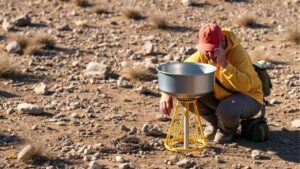Recovering Precious Metals From Gravel Layers Beneath False Bedrock
Recovering Precious Metals From Gravel Layers Beneath False Bedrock
The recovery of precious metals from gravel layers beneath false bedrock is an intricate process that combines geology, engineering, and environmental science. This article explores the techniques and considerations involved in this field, offering insights into effective methods for extracting valuable metals such as gold, silver, platinum, and palladium.
Understanding False Bedrock
False bedrock refers to a layer of material that sits atop the true bedrock, often consisting of gravel, sand, clay, or other sediments. This layer can complicate mining operations due to its variable composition and depth. significance of false bedrock lies in its potential to host valuable minerals that may have settled over millennia, making it a target for recovery operations.
Geological Considerations
Understanding the geological context of an area is essential for effective metal recovery. The sedimentary processes that lead to the formation of gravel deposits can influence the concentration of precious metals. Factors such as:
- Proximity to mineralized zones
- Historical weathering events
- Water flow dynamics
are all critical in determining the potential yield of precious metals beneath false bedrock. For example, regions with a history of ancient river systems may harbor substantial gold deposits due to the natural erosion and deposition of metals.
Extraction Techniques
Several techniques exist for recovering precious metals from gravel layers beneath false bedrock, each suited to different geological conditions:
- Alluvial Mining: This method involves the manual or mechanical excavation of gravel deposits found in riverbeds or stream beds. Traditional panning techniques are effective for small-scale operations, while larger enterprises may deploy industrial machinery.
- Dredging: This technique utilizes a specialized dredging machinery to extract materials from river beds and lagoons. Its particularly useful in areas where false bedrock is saturated with water, making manual extraction impractical.
- Hydraulic Mining: This process employs high-pressure water jets to dislodge gravel and sediments. This method is effective for large deposits of alluvial materials, although it raises significant environmental concerns due to potential river siltation.
Environmental Considerations
While extracting precious metals presents economic opportunities, it also poses environmental challenges. Practices such as hydraulic mining can damage ecosystems, disturb local water tables, and increase sedimentation in waterways. To mitigate these impacts, modern extraction operations are increasingly adopting sustainable practices which may include:
- Rehabilitation of mined areas
- Useation of sediment control measures
- Monitoring of local biodiversity
Also, regulatory frameworks often govern mining activities, necessitating compliance with environmental protection standards. Case studies such as those conducted in the Amazon basin demonstrate that balancing extraction with ecological preservation is crucial for sustainable development.
Case Studies and Real-World Applications
A notable example of successful precious metal recovery from gravel beneath false bedrock is found in the Klondike region of Canada. Here, miners have utilized dredging techniques in combination with modern technology to enhance recovery rates, achieving gold yields exceeding 100,000 ounces per year in some operations.
Similarly, in the Northern California region, alluvial mining has been integral to local economies, where operators have effectively tapped into ancient river systems, recovering significant quantities of gold while implementing rigorous environmental management practices.
Conclusion and Actionable Takeaways
Recovering precious metals from gravel layers beneath false bedrock is a complex but rewarding endeavor. Successful extraction relies on a thorough understanding of geological contexts, the implementation of suitable extraction techniques, and adherence to environmental regulations. As stakeholders in the mining industry aim for greater sustainability, innovation in technology and best practices will continue to shape the landscape of precious metal recovery.
For those interested in pursuing this field, consider the following actionable takeaways:
- Conduct thorough geological surveys to identify potential mining sites.
- Explore various extraction methods and adopt best practices for sustainability.
- Stay informed about environmental regulations and community impact assessments.
By approaching precious metal recovery with a blend of scientific rigor and environmental stewardship, the mining industry can not only thrive but also safeguard the ecosystems on which it depends.


